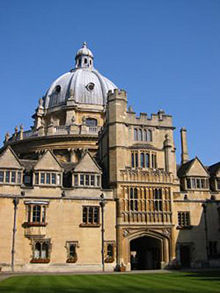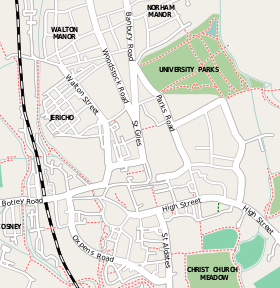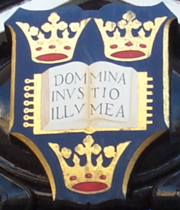Brasenose College, Oxford

|
|
||||||||||||
| College name | The King's Hall and College of Brasenose | |||||||||||
| Latin name | aula regia et collegium aenei nasi | |||||||||||
| Named after | Bronze door knocker | |||||||||||
| Established | 1509 | |||||||||||
| Sister college | Gonville and Caius College, Cambridge | |||||||||||
| Principal | Prof. Roger Cashmore | |||||||||||
| JCR president | George Lambert | |||||||||||
| Undergraduates | 360 | |||||||||||
| HCR president | Charlie Furness-Smith | |||||||||||
| Graduates | 150 | |||||||||||
| Location | Radcliffe Square | |||||||||||
|
|
||||||||||||
 Location of Brasenose College within central Oxford |
||||||||||||
| Homepage | ||||||||||||
| Boatclub | ||||||||||||
Brasenose College, originally Brazen Nose College (in full: The King's Hall and College of Brasenose, often referred to by the abbreviation BNC), is one of the constituent colleges of the University of Oxford in the United Kingdom. As of 2006, it has an estimated financial endowment of £98m.[1]
Contents |
History
The College was founded[2] in 1509 by a lawyer, Sir Richard Sutton, of Prestbury, Cheshire, and the Bishop of Lincoln, William Smyth. Smyth provided the money for the college's foundation, and Sutton acquired the property. It was built on the site of Brasenose Hall, one of the medieval Oxford institutions which originally existed just as a lodging house, but which had grown to become a seat of learning. The college still maintains traditional ties to its official Visitor, the Bishop of Lincoln.
Among the earliest to endow the new College (or Hall) was John Elton, an early Canon of Salisbury Cathedral, and later Chancellor of Hereford Cathedral, who donated funds on May 20, 1529, towards the tuition of any Elton family member who wished to attend the new Brasenose Hall.[3] Other notable early benefactors include Alexander Nowell, Joyce Frankland, Elizabeth Morley and Sarah Seymour, Duchess of Somerset.

The name "Brasenose" is thought to originate from a brazen (bronze) door knocker in the shape of a nose;[4] the nose-shaped door knocker which hangs above the high table of the main hall of Brasenose College is thought to be the original door knocker belonging to Brasenose Hall. In the 1330s, a group of students left Oxford for Stamford in Lincolnshire led by a student from Brasenose Hall, and are thought to have taken the door knocker with them. In 1890, a house in Stamford named "Brazenose" bearing a 12th-century door knocker in the shape of a nose was put on sale. The house was purchased by the college for the sake of the door knocker, which was removed and placed in the hall, believed to have been returned to its rightful home. The house, and remains of the Hall, are now part of the estate of Stamford School. Interest in the college's history by its members is still strong, and in 2006, Brasenose students made a pilgrimage to Lincoln and Stamford.
An alternative theory is that the name is a corruption of brasenhuis (brewhouse), but this is not widely accepted, and the college uses the "nose" as an informal symbol.
Location and buildings
Brasenose faces the west side of Radcliffe Square opposite the Radcliffe Camera in the centre of Oxford. The north side is defined by Brasenose Lane, while the south side reaches the High Street. To the west is Lincoln College. Although not located on Turl Street the college has links with the three Turl Street colleges (Lincoln, Jesus, and Exeter).
The main college site[5] comprises three quads, the original Front Quad, the small second quad affectionately known as the Deer Park, and the large New Quad, as well as collection of smaller houses facing Radcliffe Square and the High Street.
The original college buildings comprised a single two storey quad, incorporating the original kitchen of Brasenose Hall on the south side. In the seventeenth century a third floor was added to the quad to form the current Front Quad. A separate chapel was also built to the south, connected to the quad by a library built over a cloister as shown in a 1670 print, thus enclosing the Deer Park. The cloister was filled in to make rooms around 1807. New Quad was designed by Jackson and finished in 1911, replacing a number of existing buildings. The current site was completed in 1961 with new buildings designed by the architects Powell and Moya.
The college also has a large undergraduate annexe developed from Frewin Hall in the 1940s, and a graduate annexe shared with St Cross College was completed in 1995. A second graduate annexe, Hollybush Row, is under construction (2007).
Student life
Brasenose College Boat Club (BNCBC) is popularly held to be the oldest boat club in the world; this is impossible to verify but BNCBC is certainly the oldest collegiate boat club and took part in the first ever head race, beating Jesus College Boat Club on that occasion.
Brasenose College Rugby Football Club proudly associates itself with William Webb Ellis, the inventor of the game, founder of BNCRFC, the club's first captain, and graduate of the college. Webb-Ellis's 'outside-the-box' approach has underpinned the tactical philosophies of a long and illustrious line of BNCRFC captains.
The JCR plays a central part in the life of the undergraduate community. Offering social, recreational and welfare support to the students, the elected committee addresses many aspects of student life and liaises with the governing body and HCR representatives. A weekly report is collated and distributed on the mailing-list by official JCR Scribe and Vice-President.
The college also prides itself on its annual summer arts festival, first staged in 1994, involving various plays, pantos, comedy evenings and musical performances.
Coat of Arms
Brasenose College's coat of arms is quite complex, since it incorporates the personal arms of the founders and the arms of the See of Lincoln.[6]
In heraldic terminology: Tierced in pale: (1) Argent, a chevron sable between three roses gules seeded or, barbed vert (for Smyth); (2) or, an escutcheon of the arms of the See of Lincoln (gules, two lions of England in pale or, on a chief azure Our Lady crowned seated on a tombstone issuant from the chief, in her dexter arm the Infant Jesus, in her sinister arm a sceptre, all or) ensigned with a mitre proper; (3) quarterly, first and fourth argent, a chevron between three bugle-horns stringed sable; second and third argent, a chevron between three crosses crosslet sable (for Sutton).[7]
Because of the complexity of the arms they are not suitable for use on items such as the college crested tie, where the nose is used instead.
College prayers
The College Prayer
The college prayer is read by the principal or a fellow at evensong on Sundays during term and at gaudies.[8]
Almighty and heavenly Father, we desire thy loving-kindness upon this, our well loved Society. We implore thy blessing on those of its members who now serve thee in their several callings. Strengthen them, O Lord, to serve thee as thou deservest, and, as thou hast called them to thy service, make them worthy of their calling. And we keep for ever before thee in grateful remembrance of their lives and their sacrifice, those of our body who fell in the Wars; and into thy hands we commend them, thou God with whom do live the spirits of just men made perfect. And we pray for ourselves, that we may learn here to know and do thy will; that through thy protection, both here and ever, we may be preserved in body and soul, through our Lord and Saviour, Jesus Christ. Amen. O Lord God, in whose name are gathered here the memorials of many generations, we give thanks for all former members of this College, who have served thee with faithful labour in thy Church and Kingdom; as thou didst enable them to add their portion to thy work, so teach and strengthen us, we pray thee, to do the tasks awaiting us in this our generation; through him who offered himself to do thy will and finish thy work, Jesus Christ our Lord. Amen. O eternal God, the Resurrection and the Life of all them that believe in thee, trust in thee, and serve thee; thou that art always to be praised, as well for the dead as those that are alive; We give thee most hearty thanks for our Founders and Benefactors, by whose Bounty and Charity we are brought up to religion and the studies of good learning, and particularly for William Smyth and Richard Sutton our Founders; beseeching thee, that we may so well use these thy blessings to the praise and honour of thy holy Name, that at last, we, with them, may be brought to the immortal glory of the Resurrection; through Jesus Christ our Lord. Amen. The grace of our Lord Jesus Christ, and the love of God, and the fellowship of the Holy Ghost, be with us all evermore. Amen.
Individual benefactors are commemorated in an annual pattern, with the founders being commemorated (as shown above) on the first Sunday of Michaelmas Term, and at all gaudies.
Grace to be said before Dinner
The preprandial grace[9] is read by the Bible Clerk at Formal Hall.
Oculi omnium spectant in Te, Deus! Tu das illis escas tempore opportuno. Aperis manum Tuam et imples omne animal Tua benedictione. Mensae caelestis nos participes facias, Deus, Rex aeternae gloriae. Amen.
The eyes of all look to Thee, O God! You give them food in due season. You openest Your hand and fill every living thing with Your blessing. Make us participants at the heavenly banquet, O God, King of eternal glory. Amen.
Grace after Dinner
The grace after dinner is only read on special occasions, and the list of benefactors included in this grace is quite variable.
Qui nos creavit, redemit et pavit, sit benedictus in aeternum. Deus, exaudi orationem nostram. Agimus Tibi gratias, Pater coelestis, pro Gulielmo Smyth episcopo et Ricardo Sutton milite, Fundatoribus nostris; pro Alexandro Nowel et Jocosa Frankland, aliisque Benefactoribus nostris; humiliter Te precantes ut eorum numerum benignissime adaugeas. Ecclesiam Catholicam, et populum Christianum custodi. Haereses et errores omnes extirpa. Elizabetha Regina nostra et subditos ejus defende; Pacem da et conserva per Christum Dominum nostrum. Amen.
People associated with the College
Notable former students of the college have included politicians, scientists, writers, entertainers and academics. Perhaps the best known living Brasenose alumni are David Cameron, Leader of the Opposition, and the comedian Michael Palin, both of whom are honorary fellows. Earlier alumni include Henry Addington, Prime Minister of the United Kingdom, William Webb Ellis, often credited with the invention of Rugby football, William Golding, winner of the Nobel Prize in Literature, Douglas Haig, 1st Earl Haig, and Robert Runcie, Archbishop of Canterbury.
- See also: Alumni of Brasenose College, Oxford and Fellows of Brasenose College, Oxford
Fictional Brasenose
- Brasenose College is featured as Lonsdale College in the Inspector Morse novels and television adaptations. It appears both as Brazenface College and under its own name in Cuthbert Bede's 19th century comic novel Verdant Green, an Oxford Freshman.
- In The Science of Discworld III: Darwin's Watch by Terry Pratchett a reference is made to "those bastards over at Braseneck College", probably a parody of Brasenose.
- Thomas Love Peacock in his novel 'Crotchet Castle' (1831) has one of his characters say: 'the Friar is gone, and his learning with him. Nothing of him is left but the immortal nose, which, when his brazen head had tumbled to pieces, crying "Time's Past," was the only palpable fragment among its minutely pulverised atoms, and which is still resplendent over the portals of its cognominal college. That nose, sir, is the only thing to which I shall take off my hat, in all this Babylon of buried literature.'
- Parts of Doomsday Book (novel) by Connie Willis take place in a not-too-distant Brasenose College.
References
- ↑ Oxford College Endowment Incomes, 1973-2006 (updated July 2007)
- ↑ "A History of Brasenose: An Outline of College History". Retrieved on 2008-03-16.
- ↑ Alumni Oxoniensis: The Members of the University of Oxford, 1500-1714: Their Parentage, Birthplace, and Year of Birth, with a Record of Their Degrees. Being the Matriculation Register of the University, Alphabetically Arranged, Revised and Annotated, University of Oxford, Joseph Foster, Published by James Parker, 1891
- ↑ "A History of Brasenose: The Oddest Name in oxford". Retrieved on 2007-09-21.
- ↑ "A History of Brasenose: The Buildings". Retrieved on 2007-09-21.
- ↑ "A History of Brasenose: The College Coat of Arms". Retrieved on 2007-09-21.
- ↑ Oxford University Calendar 2001-2002 (2001) p.217. Oxford University Press ISBN 0-19-951872-6.
- ↑ Order of Service for use at the College Gaudy, The King's Hall and College of Brasenose.
- ↑ Term Card for Trinity Term 2007, Brasenose College Chapel.
External links
- Official HCR website
- JCR website
- Virtual tour of Brasenose College
- The Brasenose Quincentenary Ball website
|
|||||||||


